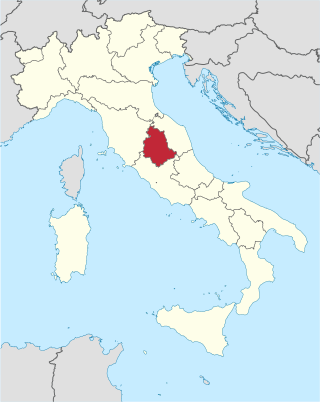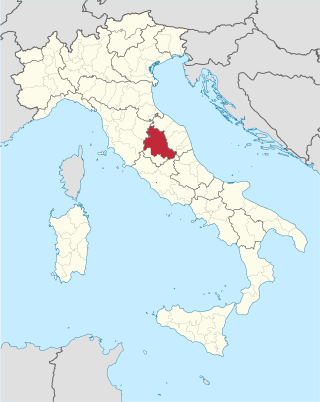
Umbria is a region of central Italy. It includes Lake Trasimeno and Marmore Falls, and is crossed by the River Tiber. It is the only landlocked region on the Apennine Peninsula. The regional capital is Perugia.
Assisi is a town and comune of Italy in the Province of Perugia in the Umbria region, on the western flank of Monte Subasio.

Gualdo Tadino is an ancient town of Italy, in the province of Perugia in northeastern Umbria, on the lower flanks of Monte Penna, a mountain of the Apennines. It is 47 kilometres (29 mi) NE of Perugia.

Fabriano is a town and comune of Ancona province in the Italian region of the Marche, at 325 metres (1,066 ft) above sea level. It lies in the Esino valley 44 kilometres (27 mi) upstream and southwest of Jesi; and 15 kilometres (9 mi) east-northeast of Fossato di Vico and 36 kilometres (22 mi) east of Gubbio. Its location on the main highway and rail line from Umbria to the Adriatic make it a mid-sized regional center in the Apennines. Fabriano is the headquarters of the giant appliance maker Indesit.

The Province of Perugia is the larger of the two provinces in the Umbria region of Italy, comprising two-thirds of both the area and population of the region. Its capital is the city of Perugia. The province covered all of Umbria until 1927, when the province of Terni was carved out of its southern third. The province of Perugia has an area of 6,334 km² covering two-thirds of Umbria, and a total population of about 660,000. There are 59 comunes in the province. The province has numerous tourist attractions, especially artistic and historical ones, and is home to the Lake Trasimeno, the largest lake of Central Italy. It is historically the ancestral origin of the Umbri, while later it was a Roman province and then part of the Papal States until the late 19th century.

Spello is an ancient town and comune (township) of Italy, in the province of Perugia in eastern-central Umbria, on the lower southern flank of Mt. Subasio. It is 6 km (4 mi) NNW of Foligno and 10 km (6 mi) SSE of Assisi.

The Basilica of Saint Francis of Assisi is the mother church of the Roman Catholic Order of Friars Minor Conventual in Assisi, a town in the Umbria region in central Italy, where Saint Francis was born and died. It is a Papal minor basilica and one of the most important places of Christian pilgrimage in Italy. With its accompanying friary, Sacro Convento, the basilica is a distinctive landmark to those approaching Assisi. It has been a UNESCO World Heritage Site since 2000.

Nocera Umbra is a town and comune in the province of Perugia, Italy, 15 kilometers north of Foligno, at an altitude of 520 m above sea-level. The comune, covering an area of 157.19 km², is one of the largest in Umbria.

Assisi Cathedral, dedicated to San Rufino, is a major church in Assisi, Italy. This stately church in Umbrian Romanesque style was the third church built on the same site to contain the remains of bishop Rufinus of Assisi, martyred in the 3rd century. The construction was started in 1140 to the designs by Giovanni da Gubbio, as attested by the wall inscription visible inside the apse. He may be the same Giovanni who designed the rose-window on the façade of Santa Maria Maggiore in 1163.

Serravalle di Chienti is a comune (municipality) in the Province of Macerata in the Italian region Marche, located about 80 kilometres (50 mi) southwest of Ancona and about 50 kilometres (31 mi) southwest of Macerata. It is crossed by the Chienti river. The communal territory is largely mountainous with numerous woods and pastures.

Valfabbrica is a comune (municipality) in the Province of Perugia in the Italian region Umbria, located about 20 km northeast of Perugia. As of 31 December 2004, it had a population of 3,542 and an area of 92.1 km2 (35.6 sq mi).

The Diocese of Nocera Umbra was a Roman Catholic diocese in Umbria, Italy.

The Italian Catholic Diocese of Assisi-Nocera Umbra-Gualdo Tadino in Umbria, has existed since 1986. In that year the historic Diocese of Assisi, known as the birthplace of Francis of Assisi, was combined with the Diocese of Nocera Umbra-Gualdo Tadino. The diocese is a suffragan of the Archdiocese of Perugia-Città della Pieve.

Marco Battista Battaglini was an Italian jurist and priest, known as a historian of the church councils. He served as Bishop of Cesena (1716–1717) and Bishop of Nocera Umbra (1690–1716).

Matteo da Gualdo or Matteo di Pietro di Ser Bernardo was an Italian painter, active in Gualdo Tadino, Nocera Umbra, and Assisi.

Gualdo Tadino Cathedral is a Roman Catholic cathedral in Gualdo Tadino in Umbria, Italy, dedicated to Saint Benedict of Nursia. Formerly a Benedictine abbey church, it became a cathedral in 1915, and is now a co-cathedral in the diocese of Assisi-Nocera Umbra-Gualdo Tadino.
The Diocese of Gualdo Tadino was a Roman Catholic diocese located in the town of Gualdo Tadino in the province of Perugia in northeastern Umbria, on the lower flanks of Mt. Penna, a mountain of the Apennines. In 1915, it was united with the Diocese of Nocera Umbra to form the Diocese of Nocera Umbra-Gualdo Tadino. Other sources indicate that it was suppressed to the Diocese of Nocera Umbra in 1066.
Tegrimus Tegrimi was a Roman Catholic prelate who served as Titular Patriarch of Jerusalem (1638–1641) and Bishop of Assisi (1630–1638).

The Assisi Diocesan Museum, in the city of Assisi, Italy, was founded in 1941 by bishop Giuseppe Placido Niccolini to preserve the most important works of art of the Assisi Cathedral and of several oratories of Assisi's confraternities. The museum is located underneath the piazza of the cathedral and has a collection consisting of about 300 works of which 100 are on display, exhibited in the museum's nine sections.
Marcello Crescenzi was a Roman Catholic prelate who served as Bishop of Assisi (1591–1630).



















